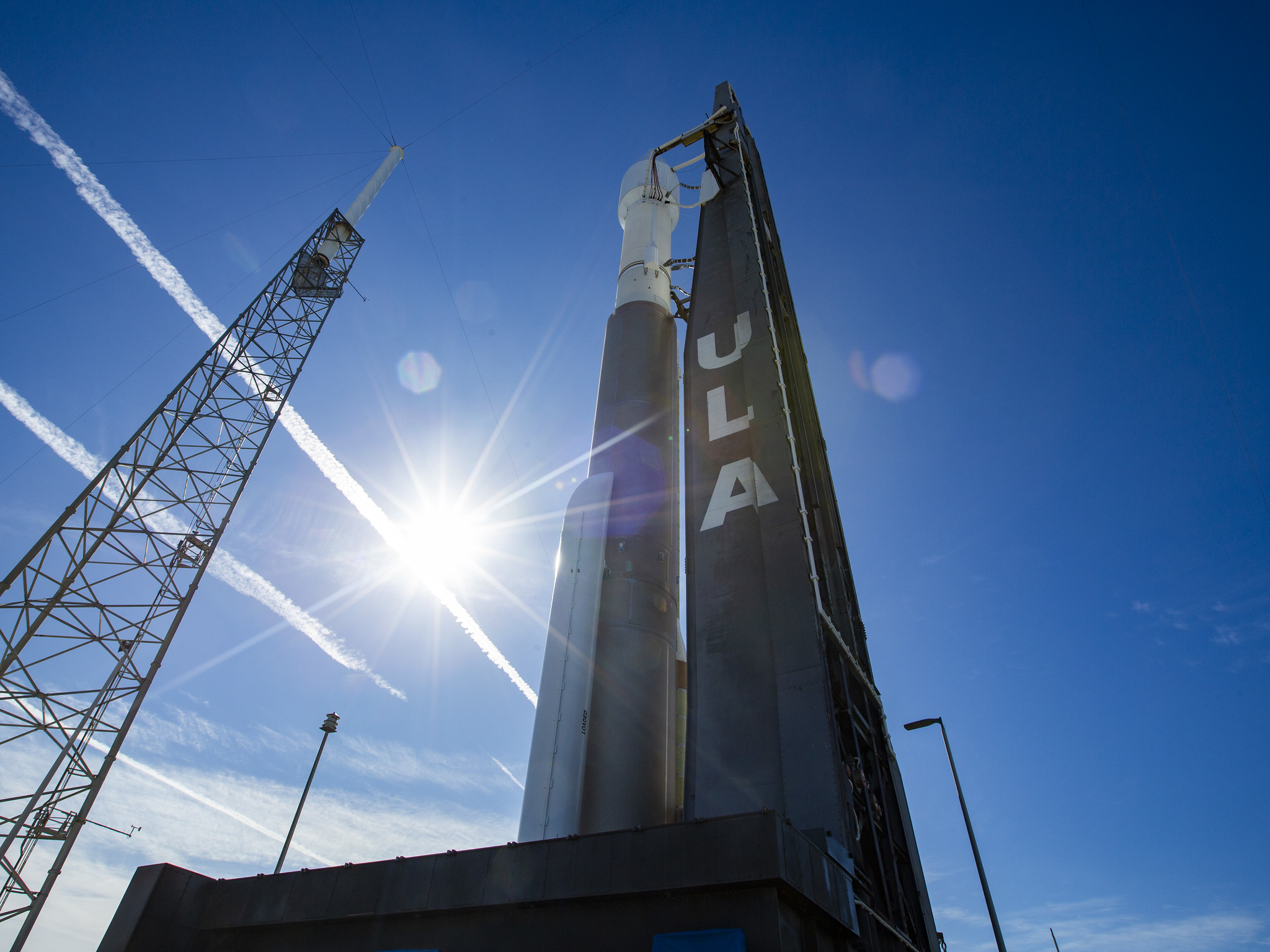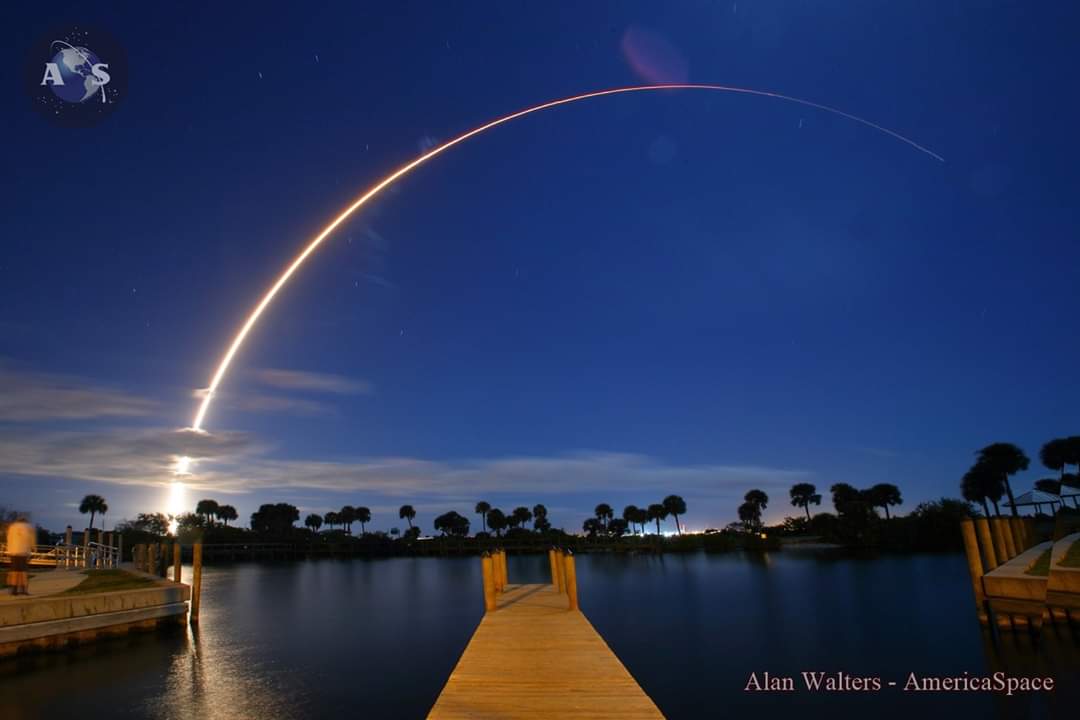
Rocket launches out of Cape Canaveral, whilst not necessarily an everyday sight, do tend to have a measure of regularity about them. But Sunday night’s spectacular 11:03 p.m. EST launch of Solar Orbiter—a European Space Agency (ESA)-led mission which will venture nearer to the Sun than ever before, achieve higher heliographic latitudes and even “hover” over portions of our star’s broiling surface—proved a peculiar sight, for it flew atop the rarely-used “411” variant of the mighty Atlas V.
Flown by United Launch Alliance (ULA) only six times since April 2006, the 411 boasts a 13-foot-wide (4-meter) payload fairing, a single-engine Centaur upper stage and one side-mounted, strap-on rocket. And it is the presence of this singular side booster that creates an unusually asymmetric “look” for the exhaust plume of the ascending vehicle. As one of few 411s to launch in the hours of darkness, that asymmetry created an unusual perspective for spectators along the Space Coast.
“As humans, we have always been familiar with the importance of the Sun to life on Earth, observing it and investigating how it works in detail, but we have also long known it has the potential to disrupt everyday life should we be in the firing line of a powerful solar storm,” said Günther Hasinger, ESA director of Science. “By the end of our Solar Orbiter mission, we will know more about the hidden force responsible for the Sun’s changing behavior and its influence on our home planet than ever before.”
“Solar Orbiter is going to do amazing things. Combined with the other recently launched NASA missions to study the Sun, we are gaining unprecedented new knowledge about our star,” said Thomas Zurbuchen, NASA’s associate administrator for Science at the agency’s headquarters in Washington. “Together with our European partners, we’re entering a new era of heliophysics that will transform the study of the Sun and help make astronauts safer as they travel on Artemis program missions to the Moon.”

The 411 first flew back in April 2006 to deliver the Astra 1KR communications satellite to geostationary transfer orbit. Capable of lifting up to 26,780 pounds (12,150 kg) to low-Earth orbit and around 13,100 pounds (5,950 kg) to geostationary altitude, the 411 saw service a second time in March 2008 when it supported the night launch of the classified NROL-28 payload for the National Reconnaissance Office. This was also its first flight out of Vandenberg Air Force Base, Calif., the Astra 1KR mission having originated out of Cape Canaveral. Five years later, in April 2011, it lofted the NROL-34 classified mission, before transporting NASA’s Origins, Spectral Interpretation, Resource Identification, Security, Regolith Explorer (OSIRIS-Rex) on the first leg of a multi-year journey to the near-Earth asteroid Bennu in September 2016. Most recently, in January 2018 it launched the fourth and latest member of the geostationary Space-Based Infrared System (SBIRS GEO-4) to support U.S. missile warning defenses.
Processing of 411 hardware for Solar Orbiter entered high gear last November, when the107-foot-long (32-meter) Common Core Booster (CCB) and the 41-foot-long (12.6-meter) Centaur arrived in Florida from Decatur, Ala., aboard ULA’s RocketShip cargo vessel. Early in January, the CCB was maneuvered inside the Vertical Integration Facility (VIF) at SLC-41 to begin the critical Launch Vehicle On Stand (LVOS) milestone. The Centaur was attached to the top of the CCB shortly thereafter and the 55.7-foot-long (17-meter) strap-on booster was affixed to the stack. In mid-January, the complete vehicle—minus its payload fairing and Solar Orbiter itself—was transported northwards about 1,800 feet (550 meters) from the VIF to the pad surface for a fully-fueled Wet Dress Rehearsal (WDR). These dress rehearsals are conducted by ULA prior to all missions with time-critical planetary launch windows and Solar Orbiter will require multiple flybys of Venus (and one of Earth) in order to achieve its close orbit around the Sun.
After a couple of days’ delay due to a problematic cold air duct that needed replacement, the WDR was successfully concluded on 24 January, after which the rocket was drained of cryogens and returned to the VIF for the integration of its two-piece (“bisector”) payload fairing, into which Solar Orbiter had been encapsulated on the 20th. The WDR delays had already obliged a launch slip from 5 to 7 February, with a further movement to the 9th resulting from schedule conflicts following SpaceX’s Starlink-3 launch and poor weather as ULA prepared to roll Solar Orbiter out to the pad. Eventually, the spacecraft in its Large Payload Fairing (LPF) arrived at SLC-41 and was hoisted atop the Atlas V on 31 January.
Following final checks—including the critical Launch Readiness Review (LRR) on Friday—the 189-foot-tall (57.6-meter) booster was rolled from the VIF to the pad surface on Saturday, 8 February. It was carefully centered and propellant umbilicals and electrical and data connections were established. Weather conditions for Sunday and two backup opportunities on Monday and Tuesday were 80% favorable, according to the USAF 45th Weather Squadron at Patrick Air Force Base, tho the odds improved to 90% at launch time.


Ignition of the Russian-heritage RD-180 engine of the CCB occurred at T-2.7 seconds, quickly ramping up to 860,000 pounds (390,000 kg) of thrust. Next, the single solid-fueled booster at its base kicked in at T-0, adding a further 348,500 pounds (158,000 kg) of propulsive yield to push the 411 stack away from SLC-41. The offset plume from the side booster was particularly apparent in this night launch, although as ULA noted before the flight the dual nozzles of the CCB main engine can more than sufficiently compensate for this peculiarity. “The steering actuators on the main engine counteract the asymmetrical thrust from the single solid,” it explained in a pre-flight overview of the 411 configuration, “to enable the rocket to fly straight, mitigating the offset thrust.”
The single booster burned for a little over two minutes, before it was jettisoned, leaving the RD-180 alone to continue the push to the edge of space. It finally shut down at four minutes and the CCB was discarded, setting the scene for two “burns” of the Centaur upper stage. Its RL10A-4-2 engine—with a propulsive yield of 22,300 pounds (10,100 kg)—was ignited for a pair of firings to insert Solar Orbiter into the appropriate location in space to begin its trans-Venus journey. The first burn ran for eight minutes, after which the stack coasted for a half-hour in an Earth “parking” orbit, before the second burn of seven minutes pushed it out of orbit and onto a Venus transfer trajectory. The spacecraft separated from the Centaur a little over 52 minutes after launch. Its first rendezvous with Venus is planned for December 2020.

Solar Orbiter’s launch marks the first of what ULA expects to be an up-tempo year of nine launches; seven Atlas V flights and two Delta IV Heavy missions. AmericaSpace previously reported that around 30 Atlas and Delta booster cores are currently at various stages of production for future missions, although ULA’s annual flight rate has dipped significantly from 12 launches in 2016 to only eight apiece in 2017 and 2018 and just five last year. The organization has also retired its expensive “single-stick” Delta product line, with the workhorse Delta II flying its swansong mission in September 2018 and the final Delta IV Medium vehicle launching last August. Only two Delta IV Heavy flights are manifested for 2020: one from the Cape in June, carrying the NROL-44 classified payload, and the second from Vandenberg Air Force Base, Calif., later in the year, which will be laden with NROL-82. Both payloads support the goals of the National Reconnaissance Office.
As for the Atlas V fleet, which is expected to continue a reasonably healthy plate of launches until it is eventually superseded by ULA’s in-development Vulcan-Centaur, seven missions are planned for 2020, including tonight’s flight of Solar Orbiter. Coming up in March, an Atlas V 551—the most powerful member of the fleet—will loft the sixth Advanced Extremely High Frequency (AEHF-6) military communications satellite on behalf of the newly-created U.S. Space Force, with two Air Force Space Command mixed-payload missions scheduled for May and the fall, NASA’s long-awaited Mars 2020 rover in July, the classified NROL-101 payload in September and at some stage the first Atlas booster to carry humans since Project Mercury astronaut Gordon Cooper, way back in May 1963.

That mission will fly Boeing’s CST-100 Starliner spacecraft on its first crewed voyage to the International Space Station (ISS). On-board the vehicle for an anticipated multi-month ISS increment will be NASA astronauts Mike Fincke and Nicole Mann, together with former shuttle commander and Boeing test pilot Chris Ferguson. But in light of Friday’s announcement by NASA and Boeing that the Orbital Flight Test (OFT) of Starliner last December suffered several critical software problems, it remains to be seen if another uncrewed test flight will be required.
.
.
FOLLOW AmericaSpace on Facebook and Twitter!
.
.





